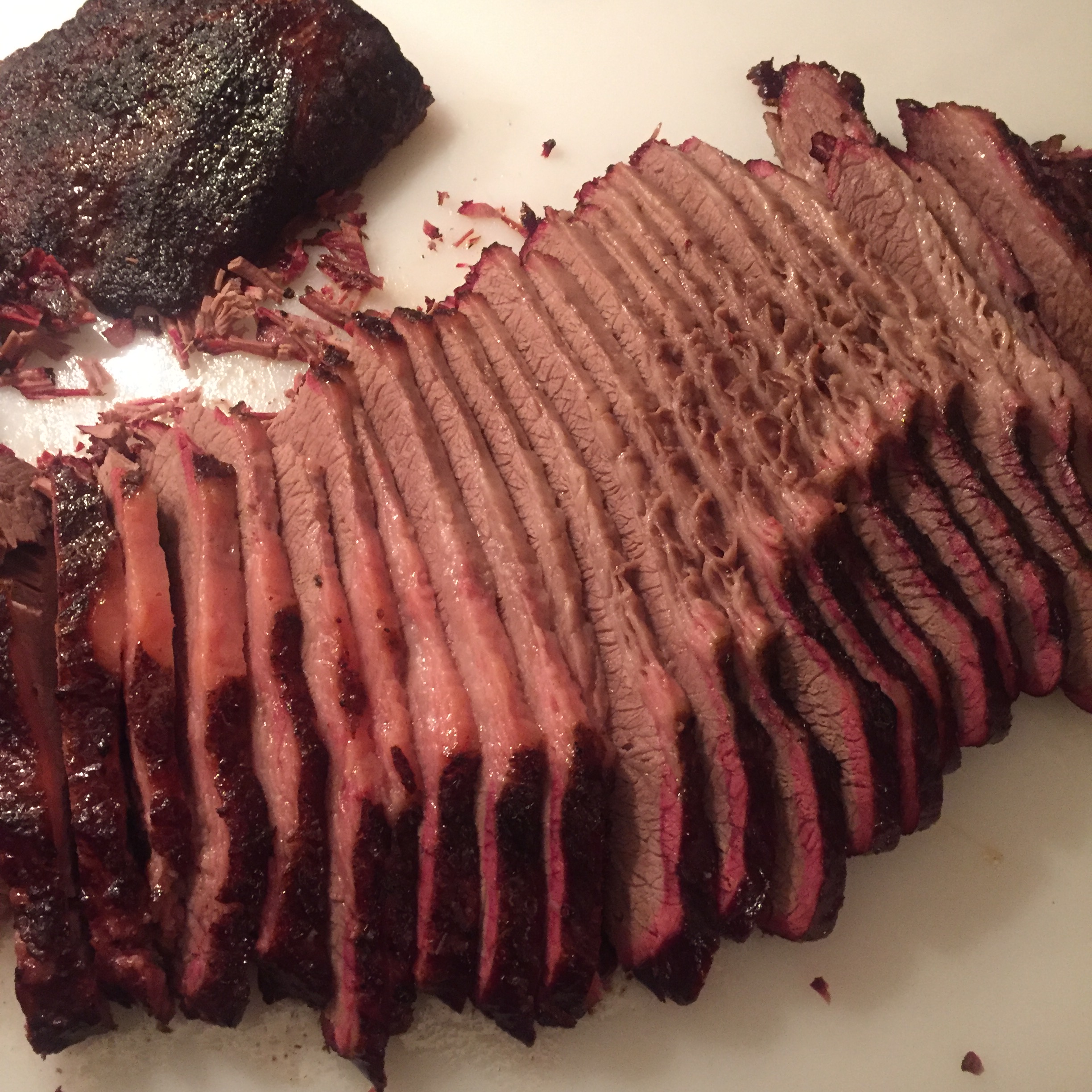
One of the undisputed secrets to good bar-b-que is time. In my estimation one of the other secrets is dry rub. Combine dry rub and time and you’re well on your way to good BBQ. I don’t know where I picked up this way of doing things but it has worked very well for me so I stick with it. The dry rub I use by far the most often is Dizzy Dust by Dizzy Pig. Hands down it’s the best all-around rub for pork shoulder, pork ribs, brisket, and even chicken that I’ve ever found. I have experimented with making my own rubs, but this is one thing where others can do it better in my experience.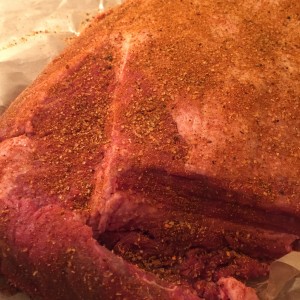
- Apply your dry rub extremely generously. Use more than you think you should.
- Wrap the meat snugly in plastic wrap. Finish with rubber bands to keep it tight and keep contact on the meat.
- Put it in the fridge at least overnight, preferably over 24 hours.
Note that I don’t rub the rub into the meat by hand. Personally I don’t think this is necessary as the contact with plastic and time does more than you could accomplish on most of it, but if you like to get your hands dirty you’re certainly not going to do any harm by getting the rub into every nook and cranny.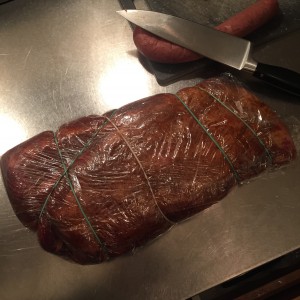
I use a Big Green Egg (BGE) for smoking (and grilling, and some baking.) They’re kind of expensive, but in my opinion worth every penny. I’ve bought a lot of dumb toys and gadgets over the years and I consistently say this is one of my best purchases. My father-in-law has been getting great results with a Masterbuilt smoker that is about $250 on Amazon, a third of the price. That said, I have never regretted the purchase and the BGE has some major advantages.
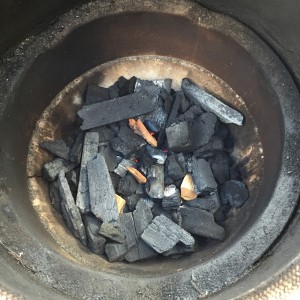
While the BGE is exceptionally good at maintaining temperature even in inclement weather, I use a piece of technology to ensure that on long overnight cooks I don’t wake up to a cold lump of charcoal and half-cooked meat. Or worse, that I don’t ruin or burn up a good piece of meat because the temp went too high. I use a device made by Rock’s Bar-B-Que called the Stoker. Basically it’s an Internet-enabled temperature controller that allows you to monitor the temp of the meat and control the temperature of the pit via a fan. It may not be “old school” but at this point I haven’t seen any pros not use a temperature controller, so I don’t have any qualms about this piece of technology. There are several on the market but I am loyal to the Stoker because it was the first to be Internet-enabled, is much more expandable than others, and has been rock-solid reliable for many many years. Their new models have WiFi, but I just plugged mine into a spare linksys to act as a bridge. (For the nerds in the house, it’s basically a Maxim TINI and the sensors are 1-wire bus sensors. It predates Arduino by at least a full generation.)
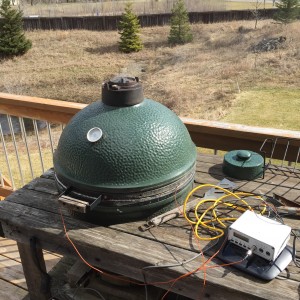
I usually start the brisket cook at 225ºF. This time I tried starting at 205 and then kicked it up to 225 after a couple hours. I don’t expect it’ll have much impact, other than on timing when it’s finished. For smoke I’ll usually use hickory chunks as I favor the sweeter, lighter smoke flavor that it imparts. I’ve used mesquite in the past but I tend to grab the hickory more often. Once the charcoal has burned off the initial smoke and the fire stabilizes at the cooking temperature I’ll add 5-6 chunks of wood. I try to place them somewhat strategically so some will burn right away and others will burn later on as the fire moves through the lump. Opening the lid and doing this will throw the temp off for a bit but it’s not a big issue as you’re putting a refrigerator-cold piece of meat in there anyway. I use an inverted ceramic “plate setter” to hold a drip tray which I usually do not fill with any liquid. Some people think adding cider or something to this will add moisture to the meat – I doubt it. I just want to catch the fat drippings so it’s not dropping on the coals and imparting a burned fat flavor.
Put the meat on, and now you wait.
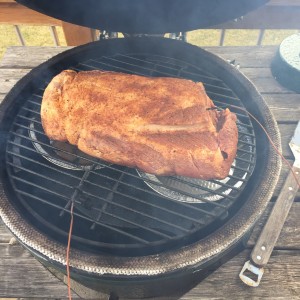 One of the big advantages of a temp controller is that you never have to open the smoker to check anything. Keeping the lid closed keeps the temp stable and the smoke in. It’s not a cheap addition to your setup, but it’s worth it for the peace of mind and consistency.
One of the big advantages of a temp controller is that you never have to open the smoker to check anything. Keeping the lid closed keeps the temp stable and the smoke in. It’s not a cheap addition to your setup, but it’s worth it for the peace of mind and consistency.
Timing with these big chunks of meat can be tricky if you don’t have a lot of experience. With brisket I plan on about 1 hour per pound, more like 1.25hours/pound if it’s a big one like this 7 pounder. Pork butts I plan for about 24 hours.
But here’s the key: don’t try to time it to be done right at eating time because you’ll get it wrong and then everybody will hate you because you’re eating hot dogs with all the great sides instead of brisket or pulled pork. Unless you have a ton of experience and you know how long it’s going to take, do what the pros do: start earlier and then wrap it up in tin foil and a layer of dish towels when it’s done and put it in a cooler, your poor man’s Cambro. The cooler will keep the temp safe for serving AND keep the meat hot and moist. When it’s time to serve, pull it out and slice (or pull).
Here’s another great reason to have a temp monitor/controller: At some point during the cook your meat is going to hit a temperature plateau that it won’t break through for hours and hours – folks call this the “stall”. I used to believe that this was a magical time during which unicorns blessed the meat with tenderness and fat by converting collagen. I have since been disabused of this notion and it changed my BBQ cooking for the better. Rather than a co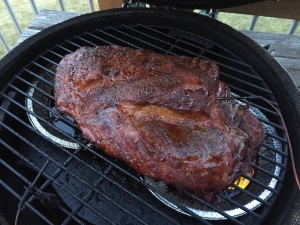 nversion process, all the plateau is is the point at which evaporation of the water in the meat reaches an equilibrium with the low-temperature cooking and results in an almost constant state of evaporative cooling until you run out of water in the meat. Not great. Now, after several hours in the smoke when the meat hits a plateau (around 155ºF) I wrap it in aluminum foil for most of the remainder of the cook. This does two (well, three) things that are beneficial: you retain more water and moisture in the meat, you get a good cup or two of delicious juice to pour over the meat later (I happen to know that some fancy chefs dip their brisket in beef stock before serving to make it more juicy), and it usually signals that you’ll be done cooking in no more than a couple hours. Depending on timing I will sometimes kick the heat up to 250 or 275 at this point to speed things up as you’re not going to hurt the meat at that point.
nversion process, all the plateau is is the point at which evaporation of the water in the meat reaches an equilibrium with the low-temperature cooking and results in an almost constant state of evaporative cooling until you run out of water in the meat. Not great. Now, after several hours in the smoke when the meat hits a plateau (around 155ºF) I wrap it in aluminum foil for most of the remainder of the cook. This does two (well, three) things that are beneficial: you retain more water and moisture in the meat, you get a good cup or two of delicious juice to pour over the meat later (I happen to know that some fancy chefs dip their brisket in beef stock before serving to make it more juicy), and it usually signals that you’ll be done cooking in no more than a couple hours. Depending on timing I will sometimes kick the heat up to 250 or 275 at this point to speed things up as you’re not going to hurt the meat at that point.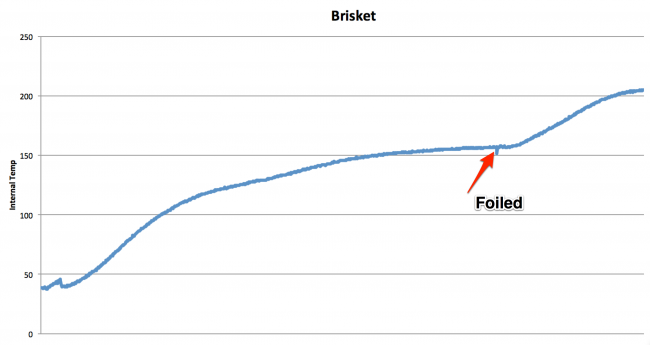
I pull it off between 195 and 205 and then let it rest for at least 20 minutes, if it’s not going into the cooler. Finally, slice it up. There are entire articles on how to slice a brisket, and I don’t get too fancy about it. This time I sliced the point off the flat and sliced that separately.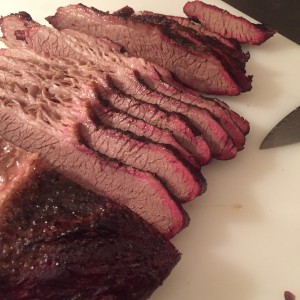
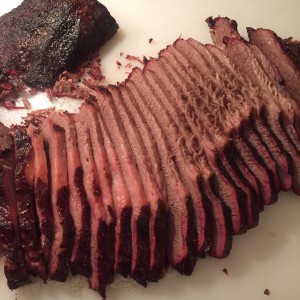
As with anything, the more you research and the more you practice the better you get. This method is my amalgamation of what I’ve learned and observed as best practices. It may not be perfect, but it produces some damn fine bar-b-que.


Leave a Reply